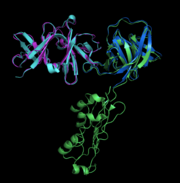Molecular Playground/Bacterial Chemotaxis Complex
From Proteopedia
|
One of the CBI Molecules being studied in the University of Massachusetts Amherst Chemistry-Biology Interface Program at UMass Amherst.
Bacterial chemotaxis is a method for cells to sense and adapt to chemicals in their environment. It is carried out by large arrays of membrane associated multi-protein complexes that form at the poles of the cells. The major players involved are the transmembrane receptor, histidine kinase CheA, and scaffold/adaptor protein CheW. Repellants and attractants bind to the periplasmic domain of the receptor. The signal is then relayed within the cytoplasm to govern CheA's kinase activity, and ultimately lead to changes in swimming behavior.
Structure
• The (1QU7) – also called methyl-accepting protein, MCP – is a ~380Å long, alpha helical homo-dimer with many domains. The (Glu295, Glu302,Glu309, Glu491) are shown by yellow color. When interacts with the receptor, it acts as a methylestrase by removing methyl groups from these 4 residues. On the other hand acts as methyltranferase by adding methyl groups to these residues.The at the cytosplasmic tip is where both CheW and CheA interact and bind.
• is a large 5-subdomain (P1-P5) histidine kinase that auto-phosphorylates depending on it's interaction with the receptor and localized concentrations of the response regulator protein CheY. This scene is of P3-P5 as a homo-dimer (1B3Q). For more information, see CheA Molecular Playground page
• The small multi-functioning adaptor and scaffolding protein (2HO9) is not directly involved in the signaling event but is essential for CheA activity.
• When combined, these three proteins assemble into large membrane associated complex primed for relaying signals from outside the cell. shows a top down view of a set of three ternary complexes with the receptor in gray, CheA in blue, and CheW in cyan. Recent cryo-EM data from the Crane Lab shows evidence for extended hexagonal arrays in which the receptors exist as trimers of dimers with rings of CheA and CheW connecting them together.
Protein Interfaces
A recent structure of the ternary complex has defined specific contacts between the protein interfaces. Although the receptor is 'unzipped' at the known hairpin loop, the specific residues at the protein-protein interfaces are still believed to be accurate because CheA and CheW align well with a previous crystal structure (Fig. 1). More information can be found here• : Residues highlighted in red are (receptor) 135, 138, 142 and (CheA) 563, 566 (4JPB)
• : Residues highlighted in red are (receptor) 137, 139-143, 145, 146, 156 and (CheW) 14, 27, 30, 98, 99 (3UR1)

